Butterflies have captivated humanity for thousands of years with their ethereal beauty and remarkable transformation. These delicate creatures flutter through our gardens and dreams carrying profound spiritual messages that transcend cultures and continents.
We’ve all witnessed the magical moment when a butterfly dances through sunlight but few of us truly understand the deeper symbolism these winged messengers represent. From ancient civilizations to modern spiritual practices butterflies embody powerful themes of rebirth renewal and personal growth that speak directly to our souls.
Whether you’ve encountered repeated butterfly sightings or you’re simply drawn to their mystical presence understanding their symbolic meaning can unlock incredible insights into your own life journey. The butterfly’s metamorphosis from caterpillar to magnificent winged creature mirrors our own potential for transformation and serves as nature’s most beautiful reminder that change leads to extraordinary possibilities.
The Universal Language of Butterfly Symbolism
Butterfly symbolism transcends cultural boundaries and speaks to humanity’s shared understanding of transformation and renewal. Across continents and throughout history, these delicate creatures have carried consistent meanings that resonate deeply within our collective consciousness.
Ancient civilizations recognized butterflies as powerful symbols of the soul’s journey. Greeks associated butterflies with Psyche, the goddess representing the human soul, while ancient Egyptians viewed them as symbols of resurrection and eternal life. Celtic traditions honored butterflies as messengers between the physical and spiritual realms, believing they carried prayers to the heavens.
Indigenous cultures worldwide have woven butterfly symbolism into their spiritual practices and folklore. Native American tribes consider butterflies sacred beings that represent change, joy, and color in life. Mexican traditions celebrate butterflies as the souls of deceased loved ones returning to visit during Día de los Muertos. Asian cultures, particularly in Japan and China, regard butterflies as symbols of marital happiness and longevity.
Contemporary spiritual practices continue to embrace butterfly symbolism as a universal sign of personal transformation. Modern interpretations focus on the butterfly’s metamorphosis as a metaphor for spiritual awakening, personal growth, and the courage to embrace change. These meanings persist across different belief systems because they reflect fundamental human experiences of growth and renewal.
The consistency of butterfly symbolism across diverse cultures demonstrates our innate recognition of transformation patterns in nature. We instinctively understand that the butterfly’s journey mirrors our own potential for profound change and spiritual evolution. This universal language of symbolism connects us to ancient wisdom while providing guidance for modern life challenges.
Transformation and Metamorphosis: The Core Meaning
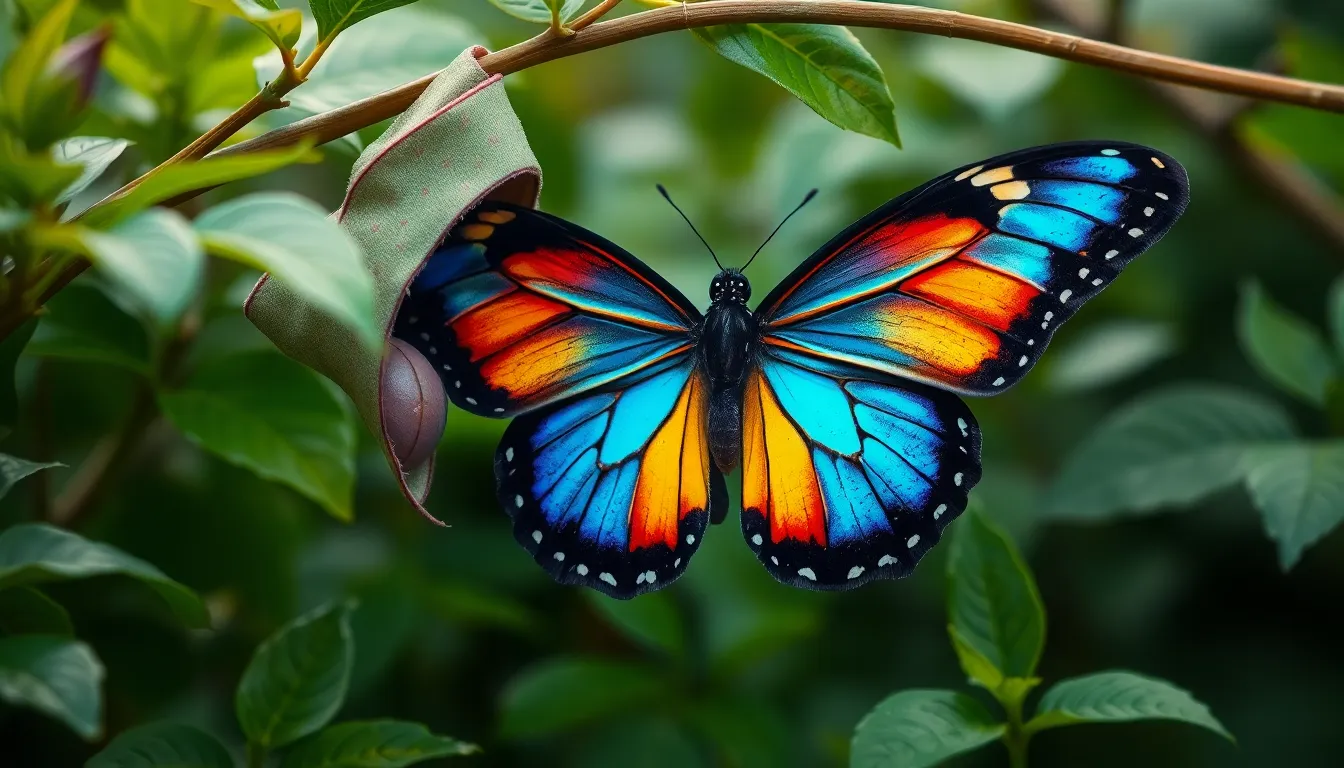
The butterfly’s life cycle embodies transformation in its purest form, moving through four distinct stages that represent profound change and renewal. We witness nature’s most dramatic example of metamorphosis as these creatures evolve from earthbound caterpillars into ethereal winged beings.
Physical Transformation as Spiritual Metaphor
Greek mythology connects butterflies directly to the soul’s eternal journey, using their transformation as a metaphor for life, death, and rebirth. Chinese culture associates these winged creatures with immortality and eternal love, while Native American traditions view them as spiritual messengers carrying divine communication. The butterfly’s ability to transcend its physical form resonates across cultures as a symbol of spiritual enlightenment and the soul’s capacity to rise above earthly limitations.
We find this spiritual interpretation particularly powerful because the butterfly literally dissolves its caterpillar form within the chrysalis before emerging completely renewed. Many spiritual traditions use this process to illustrate the concept of ego death and spiritual rebirth. The dramatic physical change mirrors our own potential for profound inner transformation.
Life Stages and Personal Growth
Each stage of butterfly development offers unique insights into human experiences of growth and challenge. The caterpillar phase represents our earthbound existence, focused on consumption and preparation for change. Christian symbolism specifically uses these stages to represent life, death, and resurrection, creating a direct parallel between the butterfly’s journey and spiritual awakening.
We observe that the cocoon stage symbolizes periods of introspection, struggle, and preparation that precede major life changes. The emergence as a fully formed butterfly represents the completion of personal transformation and the beginning of a new chapter. This life cycle reinforces concepts of endurance, hope, and the possibility of new beginnings for individuals seeking personal or spiritual growth.
The butterfly’s journey from caterpillar to chrysalis to winged adult demonstrates that transformation requires both patience and faith in the process. These stages remind us that periods of apparent stagnation or difficulty often precede our most important breakthroughs.
Cultural Interpretations of Butterfly Symbolism
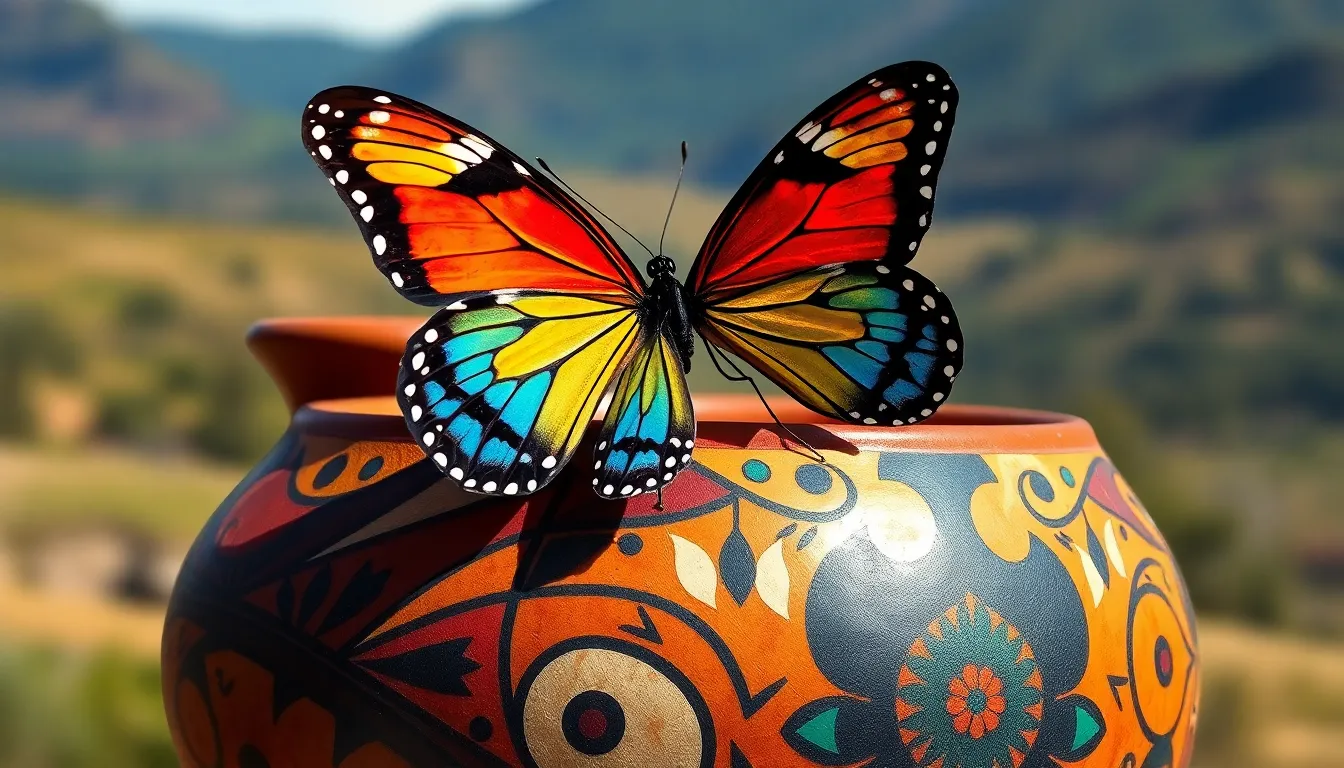
Butterfly symbolism transcends geographical boundaries and connects diverse cultures through shared themes of transformation and spiritual awakening. We find remarkable consistency in how different civilizations interpret these delicate creatures as messengers of profound change.
Ancient Greek and Roman Traditions
Ancient Greek and Roman cultures viewed butterflies as powerful symbols of the soul and eternal life. The mythology surrounding Psyche offers the most compelling example of this connection, as this mortal woman received immortality and butterfly-like wings in her transformation to goddess status. Greeks believed the butterfly represented the soul’s journey through different states of existence, while Romans adopted similar interpretations that emphasized the creature’s connection to life beyond death.
These classical civilizations recognized the butterfly’s metamorphosis as a metaphor for the soul’s immortal nature. Roman poets frequently referenced butterflies in their works about death and rebirth, establishing literary traditions that influenced Western symbolism for centuries. The strength of the human spirit found expression through butterfly imagery in their art, mosaics, and philosophical texts.
Native American Butterfly Medicine
Native American cultures embrace butterflies as sacred messengers carrying spiritual medicine between worlds. Many tribes consider butterfly encounters as communications from deceased ancestors, offering guidance during important life transitions. The Hopi tribe specifically associates butterflies with fertility and renewal, incorporating butterfly symbols into ceremonial dances and pottery designs.
Transformation energy flows through butterfly medicine teachings, where each stage of metamorphosis corresponds to different aspects of human spiritual development. Cherokee traditions view butterflies as symbols of joy and color, believing their presence brings happiness and positive energy to communities. Several southwestern tribes use butterfly imagery in healing ceremonies, recognizing these creatures as carriers of prayers to the spirit industry.
Asian Cultural Perspectives
Japanese culture deeply connects butterflies with femininity, marriage, and the soul’s journey through life and death. Traditional Japanese art and poetry frequently feature butterflies as symbols of grace and beauty, particularly in works depicting young women or romantic themes. The association with souls appears in Japanese folklore where butterflies represent the spirits of both living and deceased individuals.
Chinese traditions present butterflies as symbols of love when two appear together in flight. Tang and Song dynasty poetry celebrates this imagery, with countless verses describing paired butterflies as representations of eternal romantic devotion. Chinese folklore includes stories where lovers transform into butterflies after death, ensuring their bond continues beyond mortal existence.
Both cultures recognize butterflies as carriers of good fortune and spiritual messages. The sound of butterfly wings creates associations with respect for elders in certain Asian traditions, linking these creatures to family honor and ancestral wisdom.
Spiritual and Religious Significance
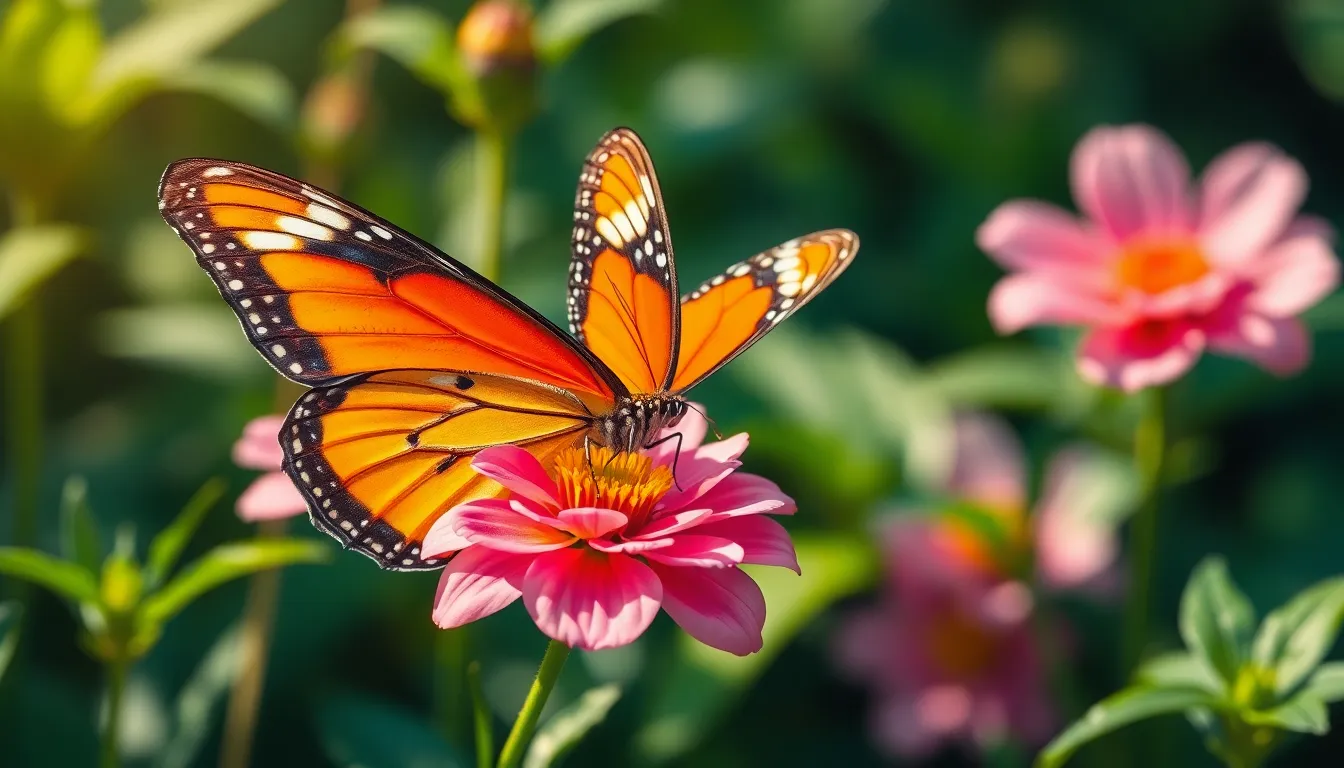
Butterflies carry profound spiritual meaning across major industry religions, serving as powerful symbols of transformation and divine connection. We find these delicate creatures woven into religious narratives that speak to humanity’s deepest questions about life, death, and spiritual awakening.
Christianity and Resurrection Symbolism
Christianity embraces butterflies as symbols of resurrection and new life, drawing direct parallels between their metamorphosis and core Christian beliefs. Christian theology connects the butterfly’s transformation from caterpillar to winged creature with the death, burial, and resurrection of Jesus Christ.
Easter celebrations particularly emphasize butterfly symbolism, representing hope and new beginnings that emerge from periods of darkness. Churches often incorporate butterfly imagery during Easter services to illustrate the promise of eternal life and spiritual rebirth available through faith.
The metamorphosis process mirrors the Christian conversion experience, where believers undergo spiritual transformation from their former selves into new creations. We see this symbolism reinforced through Christian art and literature, where butterflies represent the soul’s journey toward salvation and the promise of resurrection for all believers.
Buddhism and Soul Liberation
Buddhist philosophy recognizes transformation as a central theme in spiritual development, though butterflies don’t appear explicitly in traditional Buddhist scriptures as symbols of soul liberation. The butterfly’s metamorphosis aligns conceptually with Buddhist teachings about enlightenment and the transformation of consciousness.
Buddhist practitioners often view the butterfly’s journey as a metaphor for breaking free from the cycle of suffering and achieving spiritual awakening. The caterpillar’s dissolution within the chrysalis represents the letting go of attachments and ego-driven desires that bind us to suffering.
Buddhist meditation traditions sometimes reference the butterfly’s emergence as symbolic of the moment when practitioners achieve liberation from mental formations and experience true freedom. We observe this interpretation primarily in contemporary Buddhist teachings rather than ancient texts, reflecting modern adaptations of traditional concepts.
Color-Specific Butterfly Meanings
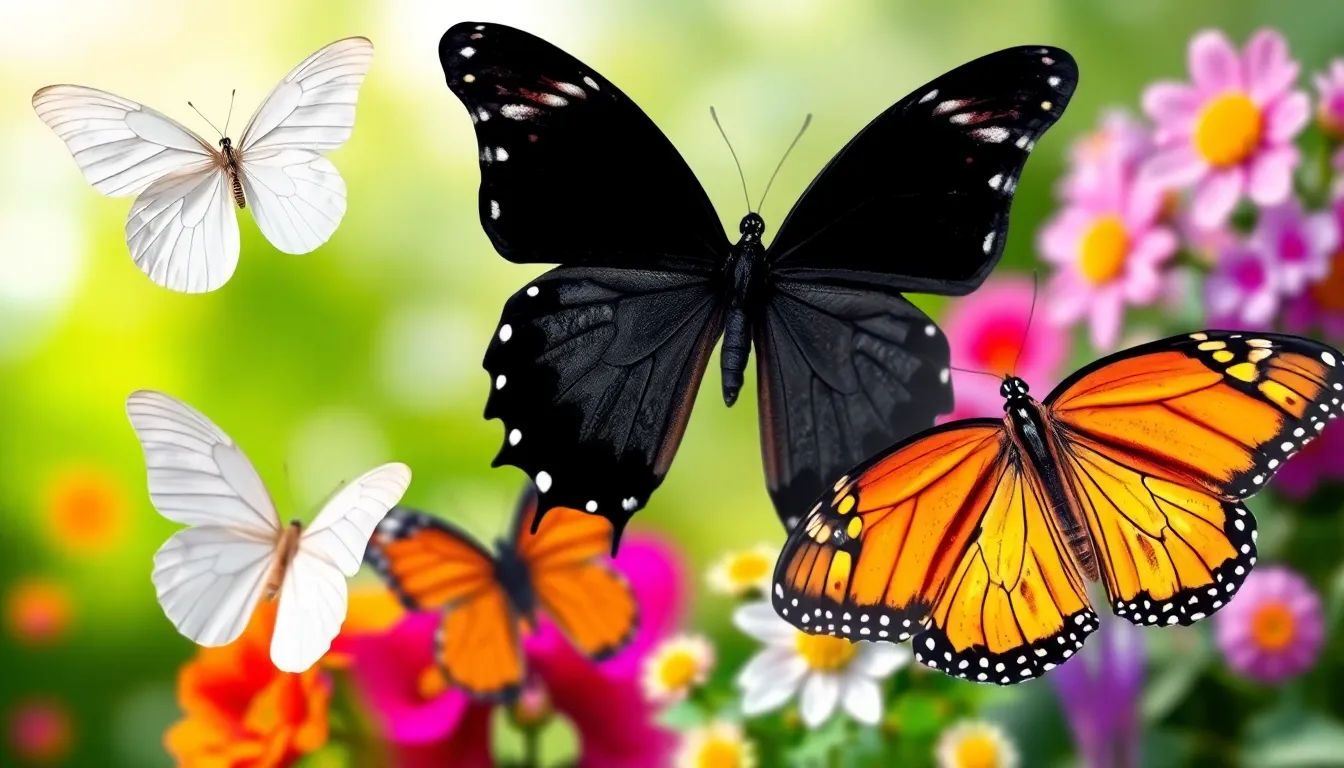
Different butterfly colors carry distinct symbolic meanings that enhance our understanding of their spiritual messages. Colors serve as powerful indicators of the exact guidance or transformation these winged messengers bring to our lives.
White Butterflies: Purity and Spiritual Messages
White butterflies represent purity and spiritual messages from beyond the physical area. These ethereal creatures often appear as messengers from the spiritual industry, bringing important guidance or messages when we encounter them. Native American cultures particularly recognize white butterflies as spiritual messengers that frequently appear in dreams to convey important communications.
Angels and spirit guides commonly use white butterflies to communicate with us during times of transition or uncertainty. Their pristine coloration symbolizes innocence, new beginnings, and divine intervention in our daily lives. Finding white butterflies in our environment suggests that we’re receiving protection and guidance from higher spiritual forces.
Black Butterflies: Death and Rebirth
Black butterflies symbolize death and rebirth rather than literal mortality or doom. This powerful symbolism connects to the groundbreaking process of releasing old patterns and embracing new phases of existence. Their dark coloration represents the dissolution phase that precedes spiritual renewal and personal transformation.
Ancient cultures understood black butterflies as symbols of the soul’s journey through challenging transitions. These creatures remind us that endings create space for extraordinary new beginnings to emerge. Encountering black butterflies often signals that we’re entering a period of profound personal change where our former selves must dissolve to allow our authentic nature to surface.
Monarch Butterflies: Endurance and Royalty
Monarch butterflies embody endurance and royalty through their remarkable migratory journeys spanning thousands of miles. These orange and black creatures travel up to 3,000 miles during their seasonal migrations, demonstrating exceptional resilience and determination. Their incredible endurance symbolizes safe passage through life’s most challenging circumstances.
Royal symbolism emerges from the monarch’s regal appearance and their ability to navigate vast distances with precision and grace. These butterflies represent our capacity to overcome obstacles while maintaining dignity and purpose throughout our journey. Monarchs teach us that true royalty comes from inner strength and the courage to pursue our destined path regardless of external challenges.
Butterfly Symbolism in Dreams and Omens
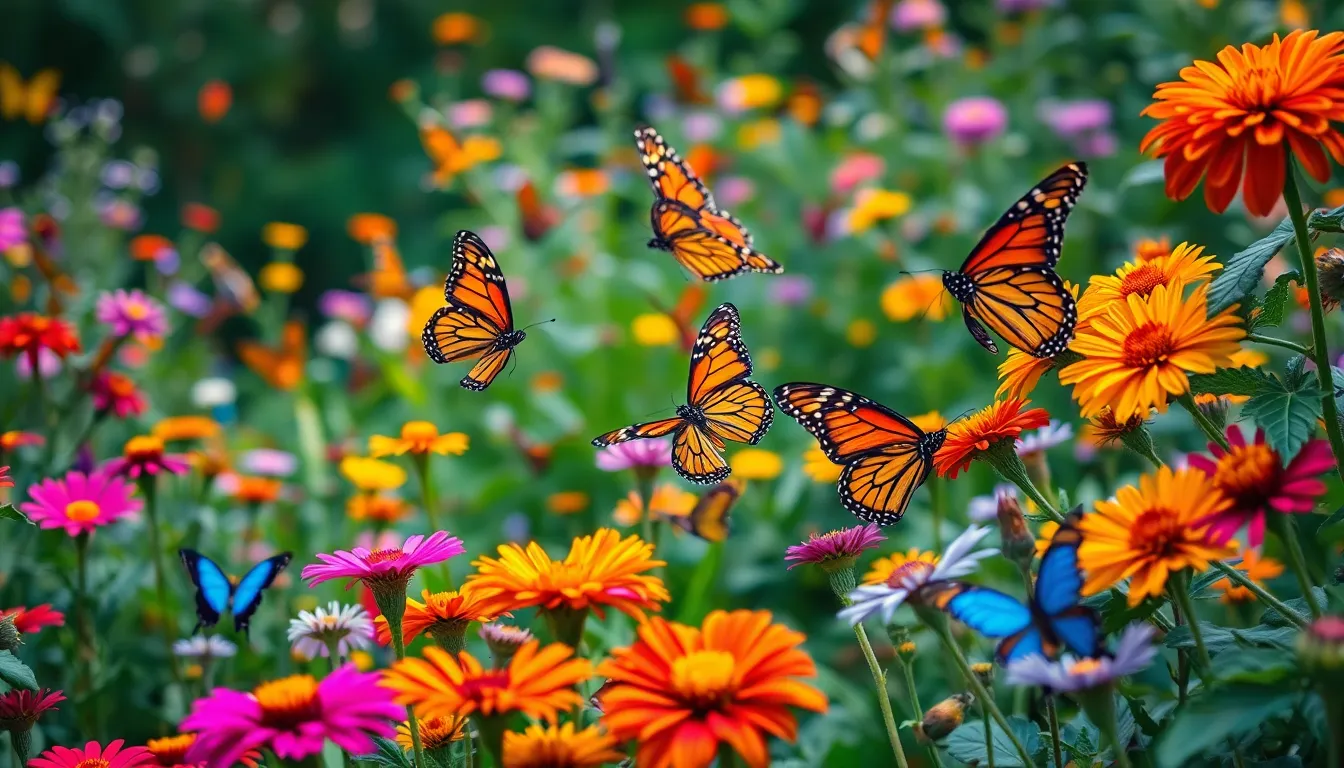
Dreams featuring butterflies carry powerful groundbreaking messages that reflect our subconscious understanding of change and renewal. Native American cultures particularly emphasize butterflies as spiritual messengers in dreams, bringing important guidance during pivotal life moments. These nocturnal visions often signal upcoming transitions or the completion of personal growth cycles we’re experiencing.
Dream interpretation of butterflies varies based on their behavior and appearance within the dreamscape. Flying butterflies typically represent freedom from constraints and the embrace of new possibilities. Emerging butterflies from cocoons symbolize breakthrough moments and the realization of our hidden potential. Multiple butterflies appearing together suggest community support during transformational periods.
Butterfly omens manifest in our waking lives as meaningful encounters that provide guidance and reassurance. Encountering butterflies during moments of uncertainty often indicates positive change approaching our circumstances. Their sudden appearance frequently coincides with periods when we’re questioning our life direction or seeking confirmation about important decisions.
Cultural interpretations of butterfly omens demonstrate consistent themes across different traditions. Chinese culture views butterfly pairs as omens of eternal love and marital harmony, particularly when spotted during relationship milestones. Greek mythology connects butterfly sightings to messages from departed souls, offering comfort during grieving processes. Contemporary spiritual practices recognize butterfly encounters as confirmation of our alignment with natural transformation cycles.
Seasonal butterfly appearances carry exact ominous meanings that enhance their symbolic impact. Spring butterfly sightings represent new beginnings and the awakening of dormant aspects within our lives. Summer encounters symbolize abundance and the full expression of our transformed selves. Autumn butterflies remind us of life’s cyclical nature and prepare us for necessary endings that precede rebirth.
Timing of butterfly encounters adds layers of meaning to their symbolic messages. Morning butterfly sightings often herald fresh starts and renewed energy for pursuing our goals. Evening appearances suggest reflection periods and the integration of recent life lessons. Repeated butterfly encounters within short timeframes amplify their significance as urgent spiritual communications requiring our immediate attention.
Modern Applications of Butterfly Meaning

Butterfly symbolism continues to evolve in contemporary society, finding new expressions in personal, therapeutic, and artistic contexts. These modern applications demonstrate how ancient wisdom adapts to current cultural needs while maintaining its groundbreaking essence.
Tattoo Symbolism and Personal Expression
Butterfly tattoos serve as powerful symbols of transformation, growth, and freedom in modern body art culture. People choose these designs to commemorate personal changes or represent new phases in their lives, making the transformation visible on their skin.
The popularity of butterfly tattoos stems from their versatility in representing individual journeys. Artists incorporate different butterfly species to convey exact meanings – monarchs for endurance, swallowtails for grace, and blue morphos for profound change. Color choices further personalize the symbolism, with black butterflies representing rebirth after difficulty and colorful designs celebrating positive transformations.
Many individuals select butterfly tattoos during important life transitions such as recovery from illness, overcoming addiction, or major career changes. These permanent markings become daily reminders of personal strength and the capacity for renewal. Placement choices also carry meaning, with butterflies on the shoulder representing the lifting of burdens and those on the wrist symbolizing freedom from constraints.
Literature and Art Representations
Contemporary literature embraces butterfly symbolism to explore themes of transformation and hope across various genres. Modern authors incorporate butterflies as metaphors for character development, using their metamorphosis to mirror protagonists’ psychological journeys. Young adult fiction particularly utilizes butterfly imagery to represent coming of age experiences and personal growth.
Art galleries showcase butterfly representations in diverse mediums, from watercolor paintings celebrating their ephemeral beauty to sculptural installations exploring environmental themes. Digital artists create butterfly imagery for wellness campaigns and therapeutic materials, reinforcing their connection to healing and recovery. Street art incorporates butterfly motifs to symbolize community transformation and urban renewal projects.
Environmental artists use butterfly imagery to highlight conservation needs and climate change impacts. Their works connect the fragility of butterfly populations with broader ecological concerns, making environmental awareness more accessible through familiar symbolism. Museum exhibitions feature butterfly art to educate visitors about metamorphosis while creating emotional connections to conservation efforts.
Wellness and therapy practitioners incorporate butterfly symbols in treatment spaces and recovery programs to represent personal transformation possibilities. Art therapy sessions often include butterfly creation exercises, allowing participants to visualize their own metamorphosis journeys. These applications demonstrate how traditional symbolism adapts to modern healing practices while maintaining its groundbreaking power.
Conclusion
Butterflies continue to captivate us with their timeless message of hope and transformation. Whether we encounter them in dreams tattoos or daily life they serve as gentle reminders that change isn’t something to fear but rather embrace.
Their symbolism transcends individual cultures and religions creating a universal language that speaks to our deepest understanding of growth and renewal. From ancient Greek mythology to modern therapy practices butterflies remain powerful symbols of our potential for positive change.
Next time you spot a butterfly take a moment to reflect on what transformation might be unfolding in your own life. These delicate messengers carry wisdom that’s both ancient and remarkably relevant to our contemporary journey of self-discovery.
Frequently Asked Questions
What do butterflies symbolize spiritually?
Butterflies symbolize transformation, rebirth, and spiritual awakening across cultures. They represent the soul’s journey through different life stages, embodying themes of renewal and personal growth. Their metamorphosis from caterpillar to winged creature serves as a powerful metaphor for spiritual transformation and the potential for extraordinary change in our lives.
Why are butterflies considered messengers from the spiritual realm?
Many cultures view butterflies as spiritual messengers because of their ethereal beauty and transformative nature. Native Americans particularly regard them as sacred beings that offer guidance during life transitions. Their sudden appearances often coincide with moments of change, making them seem like divine messages encouraging personal growth and new beginnings.
What does each stage of a butterfly’s life cycle represent?
The caterpillar stage represents earthly existence and preparation for growth. The cocoon phase symbolizes introspection, struggle, and the dissolution of old patterns. The chrysalis represents transformation and ego death. Finally, emergence as a butterfly signifies completion of personal transformation, rebirth, and the beginning of a new life chapter.
Do different colored butterflies have different meanings?
Yes, butterfly colors carry distinct symbolic meanings. White butterflies represent purity and spiritual communication, often seen as messages from deceased loved ones. Black butterflies symbolize death and rebirth, indicating the release of old patterns. Monarch butterflies embody endurance and royalty, representing inner strength and resilience through life’s challenges.
What do butterfly dreams mean spiritually?
Butterfly dreams typically signify upcoming personal transformations or spiritual awakenings. Flying butterflies in dreams represent freedom and liberation from constraints, while emerging butterflies symbolize breakthroughs and new possibilities. These dreams often reflect your subconscious understanding of necessary changes and encourage embracing transformation in your waking life.
How do different cultures interpret butterfly symbolism?
Greek mythology connects butterflies to Psyche, the goddess of the soul, representing immortality. Native Americans view them as sacred messengers and guides. Chinese culture associates butterflies with eternal love and femininity. Christianity sees them as symbols of resurrection and new life, particularly relevant during Easter celebrations, paralleling Christ’s resurrection.
What does it mean when you keep seeing butterflies?
Frequent butterfly sightings often indicate you’re entering a period of significant personal transformation. They serve as reassurance during uncertain times, suggesting that positive changes are approaching. The timing of encounters adds meaning—spring butterflies represent new beginnings, while autumn appearances remind us of life’s cyclical nature and renewal.
Are butterflies mentioned in religious texts?
While not explicitly mentioned in all religious texts, butterflies hold significant spiritual meaning across major religions. Christianity uses butterfly symbolism to represent resurrection and the soul’s transformation through faith. Buddhism aligns butterfly metamorphosis with enlightenment concepts, representing liberation from attachments and the journey toward spiritual awakening and freedom from suffering.











